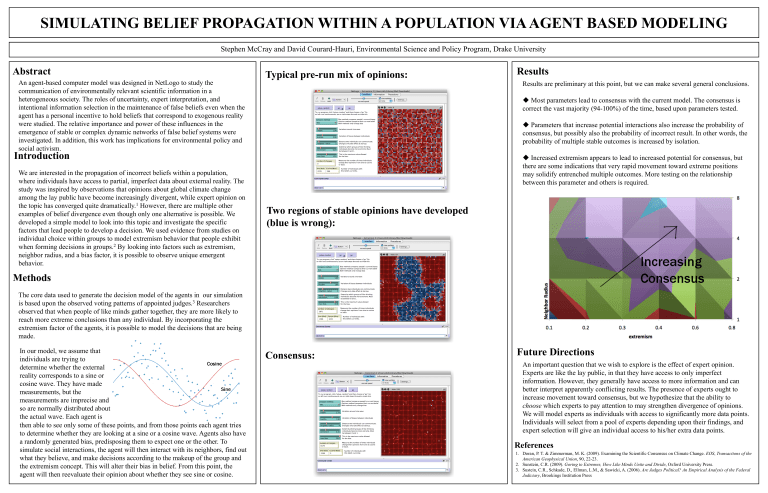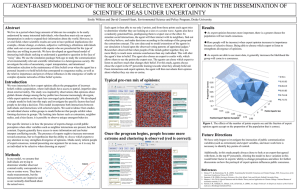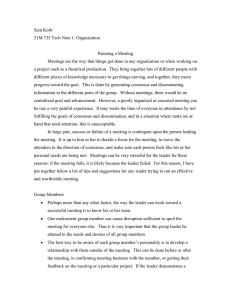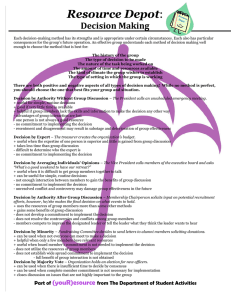Poster #21.pptx (705.4Kb)

SIMULATING BELIEF PROPAGATION WITHIN A POPULATION VIA AGENT BASED MODELING
Abstract
An agent-based computer model was designed in NetLogo to study the communication of environmentally relevant scientific information in a heterogeneous society. The roles of uncertainty, expert interpretation, and intentional information selection in the maintenance of false beliefs even when the agent has a personal incentive to hold beliefs that correspond to exogenous reality were studied. The relative importance and power of these influences in the emergence of stable or complex dynamic networks of false belief systems were investigated. In addition, this work has implications for environmental policy and social activism.
Introduction
We are interested in the propagation of incorrect beliefs within a population, where individuals have access to partial, imperfect data about external reality. The study was inspired by observations that opinions about global climate change among the lay public have become increasingly divergent, while expert opinion on the topic has converged quite dramatically.
1 However, there are multiple other examples of belief divergence even though only one alternative is possible. We developed a simple model to look into this topic and investigate the specific factors that lead people to develop a decision. We used evidence from studies on individual choice within groups to model extremism behavior that people exhibit when forming decisions in groups.
2 By looking into factors such as extremism, neighbor radius, and a bias factor, it is possible to observe unique emergent behavior.
Methods
The core data used to generate the decision model of the agents in our simulation is based upon the observed voting patterns of appointed judges.
3 Researchers observed that when people of like minds gather together, they are more likely to reach more extreme conclusions than any individual. By incorporating the extremism factor of the agents, it is possible to model the decisions that are being made.
In our model, we assume that individuals are trying to determine whether the external reality corresponds to a sine or cosine wave. They have made measurements, but the measurements are imprecise and so are normally distributed about the actual wave. Each agent is then able to see only some of these points, and from those points each agent tries to determine whether they are looking at a sine or a cosine wave. Agents also have a randomly generated bias, predisposing them to expect one or the other. To simulate social interactions, the agent will then interact with its neighbors, find out what they believe, and make decisions according to the makeup of the group and the extremism concept. This will alter their bias in belief. From this point, the agent will then reevaluate their opinion about whether they see sine or cosine.
Stephen McCray and David Courard-Hauri, Environmental Science and Policy Program, Drake University
Typical pre-run mix of opinions:
Results
Results are preliminary at this point, but we can make several general conclusions.
Most parameters lead to consensus with the current model. The consensus is correct the vast majority (94-100%) of the time, based upon parameters tested.
Parameters that increase potential interactions also increase the probability of consensus, but possibly also the probability of incorrect result. In other words, the probability of multiple stable outcomes is increased by isolation.
Increased extremism appears to lead to increased potential for consensus, but there are some indications that very rapid movement toward extreme positions may solidify entrenched multiple outcomes. More testing on the relationship between this parameter and others is required.
Two regions of stable opinions have developed
(blue is wrong):
Consensus:
Future Directions
An important question that we wish to explore is the effect of expert opinion.
Experts are like the lay public, in that they have access to only imperfect information. However, they generally have access to more information and can better interpret apparently conflicting results. The presence of experts ought to increase movement toward consensus, but we hypothesize that the ability to
choose
which experts to pay attention to may strengthen divergence of opinions.
We will model experts as individuals with access to significantly more data points.
Individuals will select from a pool of experts depending upon their findings, and expert selection will give an individual access to his/her extra data points.
References
1. Doran, P. T. & Zimmerman, M. K. (2009). Examining the Scientific Consensus on Climate Change.
EOS
,
Transactions of the
American Geophysical Union
, 90, 22-23.
2. Sunstein, C.R. (2009).
Goring to Extremes, How Like Minds Unite and Divide
, Oxford University Press.
3. Sustein, C.R., Schkade, D., Ellman, L.M., & Sawicki, A. (2006).
Are Judges Political? An Empirical Analysis of the Federal
Judiciary
, Brookings Institution Press



